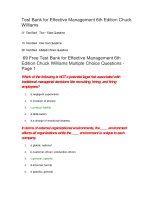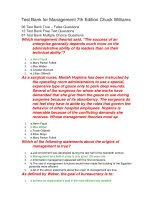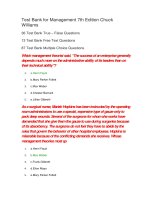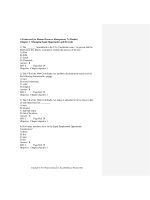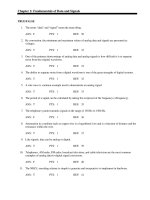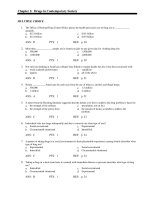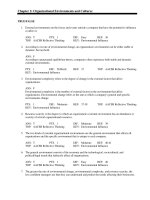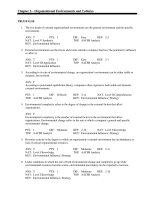Effective management 7th edition chuck williams test bank
Bạn đang xem bản rút gọn của tài liệu. Xem và tải ngay bản đầy đủ của tài liệu tại đây (587.69 KB, 45 trang )
1. The two kinds of external organizational environments are the general environment and the specific environment.
a. True
b. False
ANSWER:
True
POINTS:
1
DIFFICULTY:
Easy
REFERENCES:
2-2
NATIONAL STANDARDS: United States - Level V Synthesis
TOPICS:
AACSB Analytic
KEYWORDS:
Environmental Influence
2. External environments are the forces and events outside a company that have the potential to influence or affect it.
a. True
b. False
ANSWER:
True
POINTS:
1
DIFFICULTY:
Easy
REFERENCES:
2-1
NATIONAL STANDARDS: United States - Level III Application
TOPICS:
AACSB Analytic
KEYWORDS:
Environmental Influence
3. According to its rate of environmental change, an organization's environment can be either stable or dynamic, but not
both.
a. True
b. False
ANSWER:
False
According to punctuated equilibrium theory, companies often experience both stable and
RATIONALE:
dynamic external environments.
POINTS:
DIFFICULTY:
REFERENCES:
NATIONAL STANDARDS:
TOPICS:
KEYWORDS:
1
Difficult
2-1a
United States - Level II Comprehension
AACSB Analytic
Environmental Influence | Strategy
4. Environmental complexity refers to the degree of change in the external factors that affect organizations.
a. True
b. False
ANSWER:
False
Environmental complexity is the number of external factors in the environment that affect
RATIONALE:
organizations. Environmental change refers to the rate at which a company's general and
specific environments change.
POINTS:
DIFFICULTY:
REFERENCES:
NATIONAL STANDARDS:
1
Moderate
2-1b
United States - Level I Knowledge
TOPICS:
KEYWORDS:
AACSB Analytic
Environmental Influence | Strategy
5. Resource scarcity is the degree to which an organization's external environment has an abundance or lack of critical
organizational resources.
a. True
b. False
ANSWER:
True
POINTS:
1
DIFFICULTY:
Moderate
REFERENCES:
2-1c
NATIONAL STANDARDS: United States - Level I Knowledge
TOPICS:
AACSB Analytic
KEYWORDS:
Environmental Influence | Strategy
6. Under conditions in which the rate of both environmental change and complexity go up while environmental resources
become scarce, environmental uncertainty can be expected to increase.
a. True
b. False
ANSWER:
True
POINTS:
1
DIFFICULTY:
Moderate
REFERENCES:
2-1d
NATIONAL STANDARDS: United States - Level I Knowledge
TOPICS:
AACSB Analytic
KEYWORDS:
Environmental Influence | Strategy
7. The general segment of a company’s external environment consists of the economy and the technological, sociocultural, and political/legal trends that indirectly affect all organizations.
a. True
b. False
ANSWER:
True
POINTS:
1
DIFFICULTY:
Easy
REFERENCES:
2-2
NATIONAL STANDARDS: United States - Level I Knowledge
TOPICS:
AACSB Analytic
KEYWORDS:
Environmental Influence
8. The general segment of a company’s external environment is unique to each firm's industry and directly affects the way
it conducts day-to-day business.
a. True
b. False
ANSWER:
False
This is the definition of the specific environment. The general environment consists of the
RATIONALE:
economy and the technological, socio-cultural, and political/legal trends that indirectly affect
all organizations.
POINTS:
DIFFICULTY:
REFERENCES:
1
Easy
2-2
2-3
NATIONAL STANDARDS: United States - Level I Knowledge
TOPICS:
AACSB Analytic
KEYWORDS:
Environmental Influence
9. Changes in any sector of the general environment eventually affect most organizations.
a. True
b. False
ANSWER:
True
POINTS:
1
DIFFICULTY:
Moderate
REFERENCES:
2-2
NATIONAL STANDARDS: United States - Level I Knowledge
TOPICS:
AACSB Analytic
KEYWORDS:
Environmental Influence
10. The specific segment of an organization's external environment is unique to its region of the country.
a. True
b. False
ANSWER:
False
The specific environment is unique to the firm's industry, not region of the country.
RATIONALE:
POINTS:
1
DIFFICULTY:
Easy
REFERENCES:
2-3
NATIONAL STANDARDS: United States - Level I Knowledge
TOPICS:
AACSB Analytic
KEYWORDS:
Environmental Influence
11. Business confidence indices are a viable alternative to economic statistics for management decision making.
a. True
b. False
ANSWER:
True
POINTS:
1
DIFFICULTY:
Moderate
REFERENCES:
2-2a
NATIONAL STANDARDS: United States - Level I Knowledge
TOPICS:
AACSB Analytic
KEYWORDS:
Environmental Influence | Strategy
12. Managers often prefer economic statistics to business confidence indices as tools for managerial decision making
because of their inherently greater accuracy.
a. True
b. False
ANSWER:
RATIONALE:
False
POINTS:
DIFFICULTY:
REFERENCES:
NATIONAL STANDARDS:
TOPICS:
KEYWORDS:
1
Moderate
2-2a
United States - Level I Knowledge
AACSB Analytic
Environmental Influence | Strategy
Managers often prefer business confidence indices to economic statistics because they know
that the level of confidence reported by real managers affects their business decisions.
Unfortunately, the economic statistics that managers rely on when making these decisions
are notoriously poor predictors of future economic activity.
13. The best way to manage legal responsibilities is to retain a large staff of legal specialists to defend the company
against any charges.
a. True
b. False
ANSWER:
False
The best way to manage legal responsibilities is to educate managers and employees about
RATIONALE:
laws and regulations and potential lawsuits that could affect a business.
POINTS:
DIFFICULTY:
REFERENCES:
NATIONAL STANDARDS:
TOPICS:
KEYWORDS:
1
Easy
2-2d
United States - Level I Knowledge
AACSB Analytic
Environmental Influence | Legal Responsibilities
14. In contrast to the general segment of the external environment that DIRECTLY influences an organization, changes in
the specific segment of an organization's external environment INDIRECTLY affect the way a company conducts its
business.
a. True
b. False
ANSWER:
False
General environments INDIRECTLY influence organizations, while changes in an
RATIONALE:
organization's specific environment DIRECTLY affects the way a company conducts its
business.
POINTS:
DIFFICULTY:
REFERENCES:
NATIONAL STANDARDS:
TOPICS:
KEYWORDS:
1
Easy
2-3
United States - Level II Comprehension
AACSB Analytic
Environmental Influence | Strategy
15. Proactive customer monitoring is defined as identifying and addressing customer trends and problems after they occur.
a. True
b. False
ANSWER:
False
This defines reactive customer monitoring.
RATIONALE:
POINTS:
1
DIFFICULTY:
REFERENCES:
NATIONAL STANDARDS:
TOPICS:
KEYWORDS:
Easy
2-3a
United States - Level I Knowledge
AACSB Analytic
Environmental Influence | Strategy
16. Managers often do a poor job of identifying potential competitors.
a. True
b. False
ANSWER:
True
POINTS:
1
DIFFICULTY:
Easy
REFERENCES:
2-3b
NATIONAL STANDARDS: United States - Level I Knowledge
TOPICS:
AACSB Analytic
KEYWORDS:
Environmental Influence | Strategy
17. Buyer dependence is the degree to which a company relies on a supplier because of the importance of the supplier's
product to the company and the difficulty of finding other sources of that product.
a. True
b. False
ANSWER:
False
This is the definition of supplier dependence.
RATIONALE:
POINTS:
1
DIFFICULTY:
Easy
REFERENCES:
2-3c
NATIONAL STANDARDS: United States - Level I Knowledge
TOPICS:
AACSB Analytic
KEYWORDS:
Environmental Influence | Strategy
18. A decrease in either buyer dependence or supplier dependence can lead to opportunistic behavior.
a. True
b. False
ANSWER:
False
An increase in either buyer dependence or supplier dependence can lead to opportunistic
RATIONALE:
behavior.
POINTS:
DIFFICULTY:
REFERENCES:
NATIONAL STANDARDS:
TOPICS:
KEYWORDS:
1
Moderate
2-3c
United States - Level I Knowledge
AACSB Analytic
AACSB Ethics
Environmental Influence | Ethical Responsibilities | Strategy
19. Advocacy groups are typically composed of concerned citizens who have a strong feeling about a common issue even
though the members' viewpoints differ significantly.
a. True
b. False
ANSWER:
RATIONALE:
POINTS:
DIFFICULTY:
REFERENCES:
NATIONAL STANDARDS:
TOPICS:
KEYWORDS:
False
The members of advocacy groups generally share the same point of view on a particular
issue.
1
Moderate
2-3e
United States - Level I Knowledge
AACSB Ethics
AACSB Analytic
Environmental Influence | Ethical Responsibilities
20. The three techniques used by advocacy groups to influence companies are public communications, media advocacy,
and product boycotts.
a. True
b. False
ANSWER:
True
POINTS:
1
DIFFICULTY:
Easy
REFERENCES:
2-3e
NATIONAL STANDARDS: United States - Level I Knowledge
TOPICS:
AACSB Ethics
AACSB Communication
KEYWORDS:
Environmental Influence | Ethical Responsibilities
21. Advocacy groups cannot directly regulate organization practices.
a. True
b. False
ANSWER:
True
POINTS:
1
DIFFICULTY:
Moderate
REFERENCES:
2-3e
NATIONAL STANDARDS: United States - Level II Comprehension
TOPICS:
AACSB Analytic
AACSB Ethics
KEYWORDS:
Environmental Influence | Ethical Responsibilities
22. Because external environments can be dynamic, confusing, and complex, managers use a three-step process to make
sense of the changes in their external environments. Those steps are (1) environmental scanning, (2) interpreting
environmental factors, and (3) acting on threats and opportunities.
a. True
b. False
ANSWER:
True
POINTS:
1
DIFFICULTY:
Easy
REFERENCES:
2-4
NATIONAL STANDARDS: United States - Level I Knowledge
TOPICS:
KEYWORDS:
AACSB Ethics
Environmental Influence | Strategy
23. Managers can make sense of their changing external environments by completing all three of the following steps:
environmental scanning, interpreting environmental factors, and acting on threats and opportunities.
a. True
b. False
ANSWER:
True
POINTS:
1
DIFFICULTY:
Moderate
REFERENCES:
2-4
NATIONAL STANDARDS: United States - Level I Knowledge
TOPICS:
AACSB Analytic
KEYWORDS:
Environmental Influence | Strategy
24. Organizational culture refers to the set of key values, beliefs, and attitudes shared by organizational members.
a. True
b. False
ANSWER:
True
POINTS:
1
DIFFICULTY:
Easy
REFERENCES:
2-5a
NATIONAL STANDARDS: United States - Level II Comprehension
TOPICS:
AACSB Analytic
KEYWORDS:
Group Dynamics | HRM | Leadership Principles
25. A primary source of organizational culture is the company founder.
a. True
b. False
ANSWER:
True
POINTS:
1
DIFFICULTY:
Easy
REFERENCES:
2-5a
NATIONAL STANDARDS: United States - Level I Knowledge
TOPICS:
AACSB Analytic
KEYWORDS:
Group Dynamics | HRM | Leadership Principles
26. After the company founders are gone, stories and heroes can help to sustain the founder's values, attitudes, and beliefs
in the organizational culture.
a. True
b. False
ANSWER:
True
POINTS:
1
DIFFICULTY:
Easy
REFERENCES:
2-5a
NATIONAL STANDARDS: United States - Level I Knowledge
TOPICS:
KEYWORDS:
AACSB Analytic
AACSB Communication
Group Dynamics | HRM | Leadership Principles
27. Organizational heroes can be used to make sense of organizational events and changes.
a. True
b. False
ANSWER:
False
Organizational stories are used to make sense of organizational events and changes and to
RATIONALE:
emphasize culturally consistent assumptions, decisions, and actions. While organizational
heroes may be included in such stories, it is the story that provides the sense-making
function.
POINTS:
DIFFICULTY:
REFERENCES:
NATIONAL STANDARDS:
TOPICS:
KEYWORDS:
1
Difficult
2-5a
United States - Level I Knowledge
AACSB Analytic
AACSB Communication
Group Dynamics | HRM | Leadership Principles
28. Extensive research demonstrates clearly that organizational culture is strongly related to organizational success.
a. True
b. False
ANSWER:
False
There is only preliminary research showing that organizational culture is related to
RATIONALE:
organizational success.
POINTS:
DIFFICULTY:
REFERENCES:
NATIONAL STANDARDS:
TOPICS:
KEYWORDS:
1
Difficult
2-5b
United States - Level I Knowledge
AACSB Analytic
Group Dynamics | HRM | Leadership Principles
29. Successful organizational cultures seem to be based solely upon consistency (i.e., "strength" of the organizational
culture).
a. True
b. False
ANSWER:
False
Successful organizational cultures seem to be based upon adaptability, involvement, a clear
RATIONALE:
mission, and consistency.
POINTS:
DIFFICULTY:
REFERENCES:
NATIONAL STANDARDS:
TOPICS:
KEYWORDS:
1
Easy
2-5b
United States - Level I Knowledge
AACSB Analytic
Group Dynamics | HRM | Leadership Principles
30. The term behavioral multiplication refers to the process of having managers and employees perform new behaviors
that are central to and symbolic of the new organizational culture that a company wants to create.
a. True
b. False
ANSWER:
False
This process is called behavioral addition.
RATIONALE:
POINTS:
1
DIFFICULTY:
Easy
REFERENCES:
2-5c
NATIONAL STANDARDS: United States - Level I Knowledge
TOPICS:
AACSB Analytic
KEYWORDS:
Group Dynamics | HRM | Leadership Principles
31. When used together, the combination of behavioral substitution, behavioral addition, and changing visible artifacts is
extremely likely to achieve the desired changes in organizational culture.
a. True
b. False
ANSWER:
False
Corporate cultures are very difficult to change. Consequently, there is no guarantee that these
RATIONALE:
techniques will work.
POINTS:
DIFFICULTY:
REFERENCES:
NATIONAL STANDARDS:
TOPICS:
KEYWORDS:
1
Difficult
2-5c
United States - Level I Knowledge
AACSB Analytic
Group Dynamics | HRM | Leadership Principles
32. What are the two types of external organizational environments?
a. general and the specific
b. public and private
c. global and the national
d. organizational and the interpersonal
e. market-specific and the product-specific
ANSWER:
a
POINTS:
1
DIFFICULTY:
Easy
REFERENCES:
2-2
2-3
NATIONAL STANDARDS: United States - Level I Knowledge
TOPICS:
AACSB Analytic
KEYWORDS:
Environmental Influence
33. In terms of external organizational environments, the ____ environment affects all organizations while the ____
environment is unique to each company.
a. global; national
b. customer-driven; production-driven
c. general; specific
d. informal; formal
e. specific; general
ANSWER:
RATIONALE:
POINTS:
DIFFICULTY:
REFERENCES:
NATIONAL STANDARDS:
TOPICS:
KEYWORDS:
c
Exhibit 2.3
1
Easy
2-2
United States - Level I Knowledge
AACSB Analytic
Environmental Influence
34. All events outside a company that have the potential to influence or affect it occur in the ____ environment.
a. specific
b. external
c. formal
d. potential
e. national
ANSWER:
b
POINTS:
1
DIFFICULTY:
Moderate
REFERENCES:
2-1
NATIONAL STANDARDS: United States - Level II Comprehension
TOPICS:
AACSB Analytic
KEYWORDS:
Environmental Influence
35. Which of the following companies is most likely operating in a dynamic environment?
a. a video game manufacturer
b. a bakery
c. a brewery, winery, or distillery in the liquor industry
d. a manufacturer of pet food
e. a cereal manufacturer
ANSWER:
a
A dynamic environment is one in which the rate of change is fast. A video game maker faces
RATIONALE:
short product life cycles and rapid changes in technology.
POINTS:
DIFFICULTY:
REFERENCES:
NATIONAL STANDARDS:
TOPICS:
KEYWORDS:
1
Moderate
2-1
United States - Level I Knowledge
AACSB Analytic
Environmental Influence
36. According to the ____theory, companies go through long, simple periods of environmental stability, followed by
short, complex periods of dynamic, fundamental environmental change, finishing with a return to environmental stability.
a. environmental change theory
b. theory of environmental dynamics
c. punctuated equilibrium theory
d. theory of resource scarcity
e. environmental cycle
ANSWER:
RATIONALE:
POINTS:
DIFFICULTY:
REFERENCES:
NATIONAL STANDARDS:
TOPICS:
KEYWORDS:
c
This is the definition of punctuated equilibrium theory.
1
Moderate
2-1a
United States - Level I Knowledge
AACSB Analytic
Environmental Influence
37. Over the past 20 years, which of the following is an industry that has experienced both the stable and dynamic
environments predicted by punctuated equilibrium theory?
a. the airline industry
b. the baking industry
c. the video game industry
d. the breakfast cereal industry
e. the landscaping industry
ANSWER:
a
The U.S. airline industry is used in the text as an example of punctuated equilibrium, or a
RATIONALE:
long, simple period of stability followed by short periods of dynamic, fundamental change.
POINTS:
DIFFICULTY:
REFERENCES:
NATIONAL STANDARDS:
TOPICS:
KEYWORDS:
1
Easy
2-1a
United States - Level I Knowledge
AACSB Analytic
Environmental Influence
38. Suppose that a Mexican car manufacturer wants to export cars to Guatemala. The fact that the distribution of income
within Guatemala is highly unequal and that about 75 percent of the population is below the poverty line would be a(n)
____ component in the manufacturer’s general environment.
a. technological
b. socio-cultural
c. economic
d. political/legal
e. demographic
ANSWER:
c
POINTS:
1
DIFFICULTY:
Difficult
REFERENCES:
2-2a
NATIONAL STANDARDS: United States - Level II Comprehension
TOPICS:
AACSB Analytic
KEYWORDS:
Environmental Influence | Strategy
39. A company facing a simple environment would ____.
a. most likely be in the first stage of the environmental cycle
b. exhibit proof of the punctuated equilibrium theory
c. be unable to succeed due to lack of innovation
d. be influenced by only factors in its specific environment
e. have few external factors in the environment that affect it
ANSWER:
e
Definition of a simple environment.
RATIONALE:
POINTS:
1
DIFFICULTY:
Moderate
REFERENCES:
2-1b
NATIONAL STANDARDS: United States - Level I Knowledge
TOPICS:
AACSB Analytic
KEYWORDS:
Environmental Influence | Strategy
40. In terms of environmental complexity, ____ environments have few environmental factors, whereas ____
environments have many environmental factors.
a. non-competitive; competitive
b. simple; complex
c. stable; dynamic
d. scarce; abundant
e. market-oriented; product-oriented
ANSWER:
b
Definitions of simple and complex environments.
RATIONALE:
POINTS:
1
DIFFICULTY:
Easy
REFERENCES:
2-1b
NATIONAL STANDARDS: United States - Level II Comprehension
TOPICS:
AACSB Analytic
KEYWORDS:
Environmental Influence
41. ____ is the degree to which an organization's external environment has an abundance or scarcity of critical
organizational resources.
a. Environmental complexity
b. Environmental capacity
c. Differentiation opportunity
d. Environmental dynamism
e. Resource scarcity
ANSWER:
e
POINTS:
1
DIFFICULTY:
Easy
REFERENCES:
2-1c
NATIONAL STANDARDS: United States - Level II Comprehension
TOPICS:
AACSB Analytic
KEYWORDS:
Environmental Influence | Strategy
42. In a very strong economy, where the demand for qualified job applicants exceeds the supply, the environmental
characteristic of ____ is likely to be particularly salient for many companies.
a. environmental complexity
b. environmental change
c. resource scarcity
d. environmental uncertainty
e. environmental risk
ANSWER:
c
Resource scarcity is a lack of critical organizational resources (in this case, human
RATIONALE:
resources).
POINTS:
DIFFICULTY:
REFERENCES:
NATIONAL STANDARDS:
TOPICS:
KEYWORDS:
1
Moderate
2-1c
United States - Level I Knowledge
AACSB Analytic
Environmental Influence | Strategy
43. Environmental ____ is affected by environmental complexity, change, and resources.
a. uncertainty
b. differentiation
c. difficulty
d. essence
e. entrepreneurship
ANSWER:
a
Environmental uncertainty is defined as the extent to which managers can understand or
RATIONALE:
predict which environmental changes will affect their businesses. Complexity and change
make it more difficult for managers to achieve such understanding or make sound forecasts.
POINTS:
DIFFICULTY:
REFERENCES:
NATIONAL STANDARDS:
TOPICS:
KEYWORDS:
1
Difficult
2-1d
United States - Level I Knowledge
AACSB Analytic
Environmental Influence
44. Legislation concerning the disposal of biological wastes, the development of more sophisticated imaging machines,
and longer patient life spans would all be part of the ____ for a public hospital.
a. internal environment
b. specific environment
c. socio-cultural environment
d. general environment
e. environmental differentiation
ANSWER:
d
These are changes that indirectly affect all organizations.
RATIONALE:
POINTS:
1
DIFFICULTY:
Moderate
REFERENCES:
2-2
NATIONAL STANDARDS: United States - Level I Knowledge
TOPICS:
AACSB Analytic
KEYWORDS:
Environmental Influence
45. The ____ consists of the economy and the technological, socio-cultural, and political/legal trends that indirectly affect
all organizations.
a. economic environment
b. specific environment
c. general environment
d. indirect environment
e. direct environment
ANSWER:
c
This is the definition of general environment.
RATIONALE:
POINTS:
1
DIFFICULTY:
Easy
REFERENCES:
2-2
NATIONAL STANDARDS: United States - Level II Comprehension
TOPICS:
AACSB Analytic
KEYWORDS:
Environmental Influence
46. Which of the following is a component of the specific environment that would directly influence a restaurant's day-today operation?
a. its regular customers
b. GNP
c. a trend toward eating less fat
d. more rigid enforcement of OSHA laws
e. all of these
ANSWER:
a
Customers are a major component of a firm’s specific environment. All of the other items
RATIONALE:
would exert an indirect influence as part of the firm’s general environment.
POINTS:
DIFFICULTY:
REFERENCES:
NATIONAL STANDARDS:
TOPICS:
KEYWORDS:
1
Moderate
2-3a
United States - Level II Comprehension
AACSB Analytic
Environmental Influence
47. Changes in any sector of the general environment ____.
a. will typically not impact most organizations
b. tend to slow down how quickly an organization moves through the environmental cycle
c. inhibit the innovation process
d. influence customers first and then suppliers
e. will eventually affect most organizations.
ANSWER:
e
It is a fundamental attribute of general environment factors that they affect all organizations
RATIONALE:
over time.
POINTS:
DIFFICULTY:
REFERENCES:
NATIONAL STANDARDS:
TOPICS:
KEYWORDS:
1
Moderate
2-2
United States - Level II Comprehension
AACSB Analytic
Environmental Influence
48. Which of the following is a component of Coca-Cola's specific environment and will directly influence how it does
business?
a. Pepsi-Cola
b. laws concerning sanitation
c. inflation
d. the increased popularity of energy drinks
e. the development of vending machines that accept debit cards
ANSWER:
a
Pepsi is a direct competitor and thus a component of Coke’s specific environment.
RATIONALE:
POINTS:
1
DIFFICULTY:
Easy
REFERENCES:
2-3b
NATIONAL STANDARDS: United States - Level I Knowledge
TOPICS:
AACSB Analytic
KEYWORDS:
Environmental Influence | Strategy
49. Which of the following is a component of a book publisher's general environment and will indirectly influence how it
does business?
a. other book publishing companies
b. pornography laws
c. an advocacy group supporting free books for children
d. a trend toward less leisure time
e. paper and ink suppliers
ANSWER:
d
Leisure time trends will affect other companies such as boat manufacturers. The other
RATIONALE:
elements are part of the publisher’s specific environment.
POINTS:
DIFFICULTY:
REFERENCES:
NATIONAL STANDARDS:
TOPICS:
KEYWORDS:
1
Moderate
2-2c
United States - Level II Comprehension
AACSB Analytic
Environmental Influence | Strategy
50. Which of the following is the LEAST aggressive approach likely to be used by an advocacy group?
a. public communications
b. media advocacy
c. product boycotts
d. class action lawsuits
e. picketing
ANSWER:
a
POINTS:
1
DIFFICULTY:
Difficult
REFERENCES:
2-3e
NATIONAL STANDARDS: United States - Level II Comprehension
TOPICS:
AACSB Analytic
KEYWORDS:
Environmental Influence
51. Consider a hamburger fast-food chain that began operations prior to World War II. In which of the following would
have been part of its specific environment after the start of World War II?
a. other fast-food restaurants that sell hamburgers
b. its customers who eat burgers at least once a week
c. the meat packing company that supplied its beef
d. government-mandated beef rationing as a result of World War II
e. all of these
ANSWER:
d
Competitors, customers, and suppliers are part of a company’s specific environment at any
RATIONALE:
time. Rationing, an example of industry-specific regulation, is not a typically part of a
company’s specific environment but occurs only under certain circumstances, in this case the
need to divert resources to the war effort.
POINTS:
DIFFICULTY:
REFERENCES:
NATIONAL STANDARDS:
TOPICS:
KEYWORDS:
1
Difficult
2-3
United States - Level II Comprehension
AACSB Analytic
Environmental Influence | Strategy
52. Managers often prefer to use business confidence indices ____.
a. to identify socio-cultural trends
b. as predictors of future economic activity when making business decisions
c. which are based on intuition and experience
d. to encourage customers to make long-term buying decisions
e. to improve consumer confidence forecasts
ANSWER:
b
Economic statistics tend to be poor predictors of future business activity. Confidence indexes
RATIONALE:
measure manager sentiment, which may yield a stronger prediction of near-term economic
activity.
POINTS:
DIFFICULTY:
REFERENCES:
NATIONAL STANDARDS:
TOPICS:
KEYWORDS:
1
Difficult
2-2a
United States - Level II Comprehension
AACSB Analytic
Environmental Influence
53. Technology is the ____ used to transform inputs (raw materials, information, etc.) into outputs (products or services).
a. knowledge, tools, and techniques
b. knowledge and machinery
c. plans and machinery
d. tools and techniques
e. strategy and tactics
ANSWER:
a
POINTS:
1
DIFFICULTY:
Moderate
REFERENCES:
2-2b
NATIONAL STANDARDS: United States - Level I Knowledge
TOPICS:
AACSB Technology
AACSB Analytic
KEYWORDS:
Environmental Influence | Information Technologies
54. More premature babies than ever before are surviving due to improvements in medical knowledge and care. This
improved survival rate can be attributed to the ____ component of hospitals.
a. technological
b. socio-cultural
c. economic
d. political/legal
e. demographic
ANSWER:
a
POINTS:
1
DIFFICULTY:
Moderate
REFERENCES:
2-2b
NATIONAL STANDARDS: United States - Level II Comprehension
TOPICS:
AACSB Technology
AACSB Analytic
KEYWORDS:
Environmental Influence
55. Tourism was not the only travel-associated industry that was visibly hurt by what happened on 9/11. People decided to
vacation at home and sales of luggage and similar travel gear decreased significantly. Sales of home swimming pools
increased. This decision to stay at home reflects a change in attitudes toward the perceived safety of long-distance
traveling. This is an example of a change in the ____ component of the general environment.
a. technological
b. socio-cultural
c. economic
d. competitive
e. geographic
ANSWER:
b
POINTS:
1
DIFFICULTY:
Easy
REFERENCES:
2-2c
NATIONAL STANDARDS: United States - Level I Knowledge
TOPICS:
AACSB Analytic
KEYWORDS:
Environmental Influence
56. Fear of a lawsuit prevents many employers from giving totally honest recommendations to former employees. This
reflects a change in the ____ component of the general environment.
a. technological
b. social
c. economic
d. political/legal
e. demographic
ANSWER:
d
POINTS:
DIFFICULTY:
REFERENCES:
NATIONAL STANDARDS:
TOPICS:
KEYWORDS:
1
Easy
2-2d
United States - Level I Knowledge
AACSB Analytic
Environmental Influence
57. The manager of a company that produces a soy-based sausage wants to conduct a competitive analysis. During this
competitive analysis, he should look at ____.
a. companies that produce other brands of pork-based sausage
b. Morningstar, a company that has a complete line of soy-based products
c. companies that produce other forms of breakfast meats like bacon
d. individuals who make their own sausage
e. The manager should consider all of the listed factors.
ANSWER:
e
Competitive analysis is a process for monitoring the competition that involves identifying
RATIONALE:
competitors, anticipating their moves, and determining their strengths and weaknesses. To
understand competitive behavior, it is important that this company identify all of its likely
competitors.
POINTS:
DIFFICULTY:
REFERENCES:
NATIONAL STANDARDS:
TOPICS:
KEYWORDS:
1
Moderate
2-3b
United States - Level II Comprehension
AACSB Analytic
Environmental Influence | Strategy
58. A fast-food restaurant chain is famous for its small, square hamburgers. Which of the following would be a
component of its sociocultural environment?
a. a period of business prosperity
b. the development of fully automated drive-through windows
c. a price war with Burger King and McDonald's
d. the fact most consumers prefer eating out rather than at home
e. regulations passed by the Food & Drug Administration
ANSWER:
d
Consumer preferences are an example of a trend in general behavior, an aspect of the socioRATIONALE:
cultural environment.
POINTS:
DIFFICULTY:
REFERENCES:
NATIONAL STANDARDS:
TOPICS:
KEYWORDS:
1
Moderate
2-2c
United States - Level II Comprehension
AACSB Analytic
Environmental Influence | Strategy
59. Which of the following is NOT a dimension of the political/legal component of the general environment that governs
and regulates business behavior?
a. legislation
b. competitive products
c. court decisions
d. regulation
e. customer-initiated lawsuits
ANSWER:
b
The political/legal component includes legislation, regulation, and court decisions that govern
RATIONALE:
and regulate business behavior.
POINTS:
DIFFICULTY:
REFERENCES:
NATIONAL STANDARDS:
TOPICS:
KEYWORDS:
1
Easy
2-2d
United States - Level II Comprehension
AACSB Analytic
Environmental Influence | Legal Responsibilities
60. A fast-food restaurant chain is famous for its small, square hamburgers. Which of the following would be a
component of its general environment?
a. meat processing companies that provide its ground beef
b. consumers who will drive miles out of their way to eat a burger
c. boycotts by the Chicago organization of People for the Ethical Treatment of Animals (PETA)
d. local zoning laws that designate the appropriate distance from the street for a restaurant to be located
e. inflation
ANSWER:
e
Inflation affects all organizations. The other factors exert industry-specific influence on the
RATIONALE:
restaurant.
POINTS:
DIFFICULTY:
REFERENCES:
NATIONAL STANDARDS:
TOPICS:
KEYWORDS:
1
Difficult
2-2a
United States - Level II Comprehension
AACSB Analytic
Environmental Influence | Strategy
61. Which of the following is NOT a potential legal risk associated with traditional managerial decisions like recruiting,
hiring, and firing employees?
a. negligent supervision
b. invasion of privacy
c. product liability
d. defamation
e. a charge of emotional distress
ANSWER:
c
POINTS:
1
DIFFICULTY:
Moderate
REFERENCES:
2-2d
NATIONAL STANDARDS: United States - Level II Comprehension
TOPICS:
AACSB Analytic
AACSB Ethics
KEYWORDS:
Environmental Influence | HRM | Legal Responsibilities
62. Two homebuilders are building homes in nearby subdivisions. One is offering 2,500-square-foot homes with two-acre
yards. The other is offering a similarly sized house with quarter-acre yards. The builder offering the smaller lots cannot
keep up with demand. The builder offering the larger lots has several unsold houses. The builder with the larger lots could
use ____ to determine why his homes are not selling.
a. proactive customer monitoring
b. consumer confidence forecasts
c. demographic information
d. reactive customer monitoring
e. a competitive location study
ANSWER:
d
Reactive customer monitoring is defined as identifying and addressing customer trends and
RATIONALE:
problems after they occur.
POINTS:
DIFFICULTY:
REFERENCES:
NATIONAL STANDARDS:
TOPICS:
KEYWORDS:
1
Moderate
2-3a
United States - Level I Knowledge
AACSB Analytic
Environmental Influence | Strategy
63. ____ is used to refer to a company's practice of identifying and addressing customer trends and problems after they
occur.
a. Consumer confidence forecasts
b. Competitive analysis
c. Reactive customer monitoring
d. Proactive customer monitoring
e. Continuous data mining
ANSWER:
c
POINTS:
1
DIFFICULTY:
Easy
REFERENCES:
2-3a
NATIONAL STANDARDS: United States - Level I Knowledge
TOPICS:
AACSB Analytic
KEYWORDS:
Environmental Influence | Strategy
64. Two homebuilders are building homes in nearby subdivisions. One is offering 2,500-square-foot homes with two-acre
yards. The other is offering a similar size of house with quarter-acre yards. The builder offering the smaller lots cannot
keep up with demand. The builder offering the larger lots has several unsold houses. The builder with the smaller lots
most likely used ____ to determine what homebuyers desired.
a. reactive customer monitoring
b. proactive customer monitoring
c. competitive analysis
d. environmental munificence
e. consumer confidence forecasts
ANSWER:
b
Proactive customer monitoring is defined as identifying and addressing customer needs,
RATIONALE:
trends and issues before they occur.
POINTS:
DIFFICULTY:
REFERENCES:
1
Difficult
2-3a
NATIONAL STANDARDS: United States - Level II Comprehension
TOPICS:
AACSB Analytic
KEYWORDS:
Environmental Influence | Strategy
65. ____ involves deciding who your competitors are, anticipating competitors' moves, and determining competitors'
strengths and weaknesses.
a. Competitive mapping
b. A market audit
c. A SWOT analysis
d. A proactive strategy
e. A competitive analysis
ANSWER:
e
POINTS:
1
DIFFICULTY:
Easy
REFERENCES:
2-3b
NATIONAL STANDARDS: United States - Level III Application
TOPICS:
AACSB Analytic
KEYWORDS:
Environmental Influence | Strategy
66. Companies doing a competitive analysis typically err by ____.
a. doing an incomplete job of identifying competitors
b. overestimating their competition
c. ignoring proactive monitoring
d. relying on competitive intelligence
e. doing all of these
ANSWER:
a
Managers tend to focus on two or three well-known competitors and may overlook less
RATIONALE:
visible/familiar competitors.
POINTS:
DIFFICULTY:
REFERENCES:
NATIONAL STANDARDS:
TOPICS:
KEYWORDS:
1
Moderate
2-3b
United States - Level I Knowledge
AACSB Analytic
Environmental Influence
67. Typically the most important factor in the relationship between companies and their suppliers is ____.
a. how dependent they are on each other
b. how much they know about each other
c. how compatible their organizational cultures are
d. the type of product being manufactured
e. all of these
ANSWER:
a
A high degree of buyer or seller dependence can lead to opportunistic behavior by one party
RATIONALE:
at the expense of the other.
POINTS:
DIFFICULTY:
REFERENCES:
1
Easy
2-3c
NATIONAL STANDARDS: United States - Level III Application
TOPICS:
AACSB Analytic
KEYWORDS:
Environmental Influence | Strategy
68. An increase in ____ can lead to opportunistic behavior in which one party benefits at the expense of the other.
a. managerial commitment
b. buyer dependence
c. industry regulation
d. advocacy group activities
e. consumer confidence indicators
ANSWER:
b
POINTS:
1
DIFFICULTY:
Moderate
REFERENCES:
2-3c
NATIONAL STANDARDS: United States - Level I Knowledge
TOPICS:
AACSB Analytic
KEYWORDS:
Environmental Influence | Strategy
69. The creation of Ingram Distribution allows booksellers to streamline the ordering and return procedures of their books.
Ingram made all the books bookstore owners wanted available in one centralized warehouse. Many new bookstore owners
would be unwilling and/or unable to return to the method of ordering books from the individual publishers. This is an
example of the creation of ____.
a. high buyer dependence on a supplier
b. pure competition
c. transactional freedom
d. high supplier dependence on a buyer
e. none of these
ANSWER:
a
A high degree of buyer or seller dependence can lead to opportunistic behavior by one party
RATIONALE:
at the expense of the other.
POINTS:
DIFFICULTY:
REFERENCES:
NATIONAL STANDARDS:
TOPICS:
KEYWORDS:
1
Moderate
2-3c
United States - Level II Comprehension
AACSB Analytic
Environmental Influence | Strategy
70. Small manufacturers are successful often because Wal-Mart agrees to carry their products. If Wal-Mart does not like a
price increase, it often will refuse to do business with the manufacturer. At this point, many small manufacturers will offer
price reductions because they fear failure if they lose the Wal-Mart account. The relationship between these small
manufacturers and Wal-Mart can be described as ____.
a. buyer dependent
b. relationship-based
c. transformational
d. supplier dependent
e. none of these
ANSWER:
a
RATIONALE:
A high degree of buyer or seller dependence can lead to opportunistic behavior by one party
at the expense of the other.
POINTS:
DIFFICULTY:
REFERENCES:
NATIONAL STANDARDS:
TOPICS:
KEYWORDS:
1
Moderate
2-3c
United States - Level II Comprehension
AACSB Analytic
Environmental Influence | Strategy
71. A high degree of buyer or seller dependence can lead to ____ in which one party benefits at the expense of the other.
a. relationship behavior
b. transactional behavior
c. behavioral monogamy
d. relational monopoly
e. opportunistic behavior
ANSWER:
e
POINTS:
1
DIFFICULTY:
Easy
REFERENCES:
2-3c
NATIONAL STANDARDS: United States - Level II Comprehension
TOPICS:
AACSB Analytic
KEYWORDS:
Environmental Influence | Strategy
72. In setting up his new office, an attorney wanted furnishings that were elegant and that would make him look
successful. He wanted thick, plush carpeting in his office, but federal regulations state that his office must be wheelchair
accessible because it is a public area. Wheelchairs do not maneuver well in thick carpeting. The building inspector had
him remove the expensive carpeting and replace it with a carpet that did allow for wheelchair maneuverability. This is an
example of how the ____ component of a company’s specific environment influences it.
a. socio-cultural
b. economic
c. political/legal
d. supplier
e. industry regulation
ANSWER:
e
Industry regulation includes rules that govern business practices and procedures, including
RATIONALE:
accessibility for disabled workers.
POINTS:
DIFFICULTY:
REFERENCES:
NATIONAL STANDARDS:
TOPICS:
KEYWORDS:
1
Moderate
2-3d
United States - Level II Comprehension
AACSB Analytic
AACSB Diversity
Environmental Influence | Ethical Responsibilities | Legal Responsibilities
73. An emphasis on ____ is likely to decrease opportunistic behavior but will never completely eliminate it.
a. buyer dependence
b. supplier dependence
c. industry regulation
d. relationship behavior
e. competitive advocacy
ANSWER:
d
A high degree of buyer or seller dependence can lead to opportunistic behavior by one party
RATIONALE:
at the expense of the other. Relationship behavior focuses on establishing long-term, mutually
beneficial relationships.
POINTS:
DIFFICULTY:
REFERENCES:
NATIONAL STANDARDS:
TOPICS:
KEYWORDS:
1
Difficult
2-3c
United States - Level II Comprehension
AACSB Analytic
Environmental Influence | Ethical Responsibilities
74. A fast-food restaurant chain is famous for its small, square hamburgers. Which of the following would be an industry
regulation component of its specific environment?
a. an increase in the prime lending rate
b. local health inspectors
c. class-action suits against all fast-food restaurants
d. inflation
e. all of these
ANSWER:
b
Industry regulations and rules govern the business practices and procedures of specific
RATIONALE:
industries, businesses, and professions. The restaurant industry is regulated by local health
inspectors.
POINTS:
DIFFICULTY:
REFERENCES:
NATIONAL STANDARDS:
TOPICS:
KEYWORDS:
1
Moderate
2-3d
United States - Level I Knowledge
AACSB Analytic
Environmental Influence | Strategy
75. ____ is a tactic in which an advocacy group actively tries to convince consumers not to purchase a company's product
or service.
a. Lobbying
b. Public communications
c. Media advocacy
d. Product boycott
e. Market denigration
ANSWER:
d
Media advocacy is defined as a tactic that involves framing issues as public issues; exposing
RATIONALE:
questionable, exploitative, or unethical practices; and forcing media coverage by buying
media time or creating controversy that is likely to receive extensive news coverage.
Lobbying, public communications, and market denigration are not listed in the book as
advocacy tactics.
POINTS:
DIFFICULTY:
REFERENCES:
1
Easy
2-3e
NATIONAL STANDARDS: United States - Level II Comprehension
TOPICS:
AACSB Communication
KEYWORDS:
Environmental Influence
76. Advocacy groups use a variety of tactics to convince businesses to comply with the group's stand on issues. Which of
the following advocacy group tactics would be most likely to cause a business to fail?
a. media advocacy
b. product boycotts
c. public communications
d. requiring a business license
e. lobbying
ANSWER:
b
Product boycotts are the most aggressive public advocacy tactic, as they may directly impact
RATIONALE:
a company’s potential to profit and grow.
POINTS:
DIFFICULTY:
REFERENCES:
NATIONAL STANDARDS:
TOPICS:
KEYWORDS:
1
Moderate
2-3e
United States - Level II Comprehension
AACSB Communication
AACSB Analytic
Environmental Influence | Strategy
77. The first step managers use to make sense of their changing environments is ____.
a. environmental scanning
b. perceptual re-engagement
c. modifying budgets
d. downsizing
e. benchmarking
ANSWER:
a
Environmental scanning precedes action steps such as downsizing, modifying budgets, or
RATIONALE:
benchmarking. Perceptual re-engagement is a red herring.
POINTS:
DIFFICULTY:
REFERENCES:
NATIONAL STANDARDS:
TOPICS:
KEYWORDS:
1
Easy
2-4a
United States - Level III Application
AACSB Analytic
Environmental Influence | Leadership Principles | Strategy
78. Which of the following is one of the steps in the process that managers use to make sense of their changing
environments?
a. perceptual re-engagement
b. environmental laddering
c. acting on threats and opportunities
d. creating strategic windows
e. behavioristic relations
ANSWER:
c
POINTS:
1
